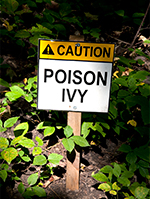
Dave: Norbert, do you know what the most common allergic reaction is in the US?
Norbert: Nowadays it seems like everyone's allergic to gluten or nuts!
Dave: No, it's actually a rash from poison ivy.
Each year, more than 10 million Americans develop rashes from poisonous plants such as poison ivy, poison oak, and poison sumac.
Up to 75% of these people are allergic to an oily sap on the leaves, stems, and roots and it's called urushiol (u-ROO-she-ol). It causes an intensely itchy, burning blistery rash that swells about 12 to 72 hours after contact with the oil. Inhaling smoke from burning poison ivy can be worse, causing breathing difficulties and even death.
We actually know very little about why urushiol causes a rash. In a new study, scientists identified a molecule called IL-33 that's produced in higher amounts after mice are exposed to urushiol.
IL-33 is a molecule involved in regulating the immune response. It binds to a receptor on cells called ST2 found on a variety of organs including immune cells and neurons in the skin. IL-33 binds to ST2 on the neurons which activates the itch. The immune cells then stimulate inflammation.
To counteract this response, the researchers used antibodies that bind to and inactivate IL-33 or ST2 in mice exposed to urushiol. As a result the mice didn't scratch as much. Then researchers used molecular biology tricks to eliminate ST2 from neurons and the mice also improved.
If this works in humans, it'd be an improvement over steroids, which affect the whole body and can have side effects.
More Information
New research seeks to stop poison ivy's itch
A new method of stopping the itch caused by poison ivy worked well in mice, researchers report.
Poison ivy, oak, and sumac: Overview
Many people get a rash from poison ivy, poison oak, and poison sumac. This rash is caused by an oil found in the plants. This oil is called urushiol (you-ROO-shee-all).
Poison Ivy: An Exaggerated Immune Response to Nothing Much
The poison ivy plant and its relatives are common throughout the United States. Poison ivy leaves are coated with a mixture of chemicals called urushiol. When people get urushiol on their skin, it causes an allergic contact dermatitis...